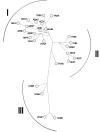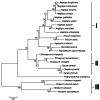Characterization of x-type high-molecular-weight glutenin promoters (x-HGP) from different genomes in Triticeae
- PMID: 23687628
- PMCID: PMC3655216
- DOI: 10.1186/2193-1801-2-152
Characterization of x-type high-molecular-weight glutenin promoters (x-HGP) from different genomes in Triticeae
Abstract
The sequences of x-type high-molecular-weight glutenin promoter (x-HGP) from 21 diploid Triticeae species were cloned and sequenced. The lengths of x-HGP varied from 897 to 955 bp, and there are 329 variable sites including 105 singleton sites and 224 polymorphic sites. Genetic distances of pairwise X-HGP sequences ranged from 0.30 to 16.40% within 21 species and four outgroup species of Hordeum. All five recognized regulatory elements emerged and showed higher conservation in the x-HGP of 21 Triticeae species. Most variations were distributed in the regions among or between regulatory elements. A 22 bp and 50 bp insertions which were the copy of adjacent region with minor change, were found in the x-HGP of Ae. speltoides and Ps. Huashanica, and could be regarded as genome specific indels. The phylogeny of media-joining network and neighbour-joining tree both supported the topology were composed of three sperate clusters. Especially, the cluster I comprising the x-HGP sequences of Aegilops, Triticum, Henrardia, Agropyron and Taeniatherum was highly supporting by both network and NJ tree. As conferring to higher level and temporal and spatial expression, x-HGP can used as the source of promoter for constructing transgenic plants which allow endosperm-specific expression of exogenous gene on higher level. In addition, the x-HGP has enough conservation and variation; so it should be valuable in phylogenetic analyses of Triticeae family members.
Keywords: Evolution analysis; Regulatory element; Triticeae; x-type high-molecular-weight glutenin promoter (x-HGP).
Figures






References
-
- Anderson OD, Abraham-Pierce FA, Tam A. Conservation in wheat high-molecular-weight glutenin gene promoter sequences: comparisons among loci and among alleles of the Glu-B1-1 locus. Theor Appl Genet. 1998;96:568–576. doi: 10.1007/s001220050775. - DOI
LinkOut - more resources
Full Text Sources
Other Literature Sources
Research Materials

